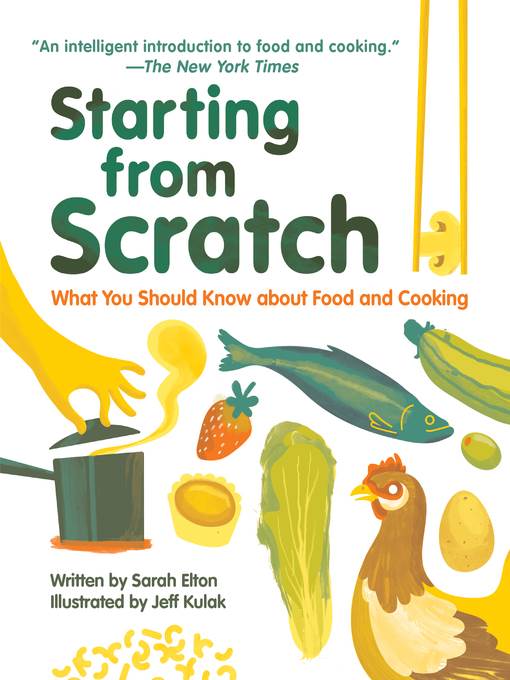
Starting from Scratch
What You Should Know about Food and Cooking
فرمت کتاب
ebook
تاریخ انتشار
2014
Lexile Score
960
Reading Level
5-6
نویسنده
Jeff Kulakناشر
Owlkids Books Inc.شابک
9781771470933
کتاب های مرتبط
- اطلاعات
- نقد و بررسی
- دیدگاه کاربران
نقد و بررسی

April 1, 2014
Gr 4-8-For those kids who love cooking and eating, this title should be required reading. The introduction answers the question "Why should you cook?" and the following six chapters detail the elements that make up food, cooking, and the eating experience. The first chapter deconstructs taste, not just covering the five tastes and taste buds, but also the terroir (how growing conditions change taste) level. "You Are What You Eat" is not about nutrition but about food culture. Another chapter discusses the science of cooking and how each cooking tool or method changes food: heat, cold, acid, salt, sweet, fat, bugs (bacteria, fungi, and mold), water, kneading, and preserving. The section about recipes explains not only how to read them but also about ratios, substitutions, and measurements. Getting the kitchen ready for cooking is covered in the next chapter, which includes lists of tools, basic pantry items, techniques for grocery shopping, and healthy eating basics and also addresses how politics and religion affect food choices. Finally, the last chapter gets to cooking techniques, food safety, table-setting illustrations (Western, Japanese, Ethiopian, and Indian), and cleaning up. Appendixes include a few basic recipes, recommended cookbooks, a guide to flavor pairings, and measurements and conversions. Decorated throughout with cartoon illustrations and written in a clear and engaging style, this title has plenty of kid appeal. With this book in hand, young chefs will be empowered to create amazing food. It will also make a great complement to science-fair projects about taste or kitchen chemistry.-Heather Acerro, Rochester Public Library, MN
Copyright 2014 School Library Journal, LLC Used with permission.

February 1, 2014
For young people beginning to take an interest in cooking, Canadian food writer Elton offers an overview of the world of food, a context for kids' adventures in the kitchen. "So why do we taste different flavors?" "Why are Mexican foods spicier than French foods?" "What is a healthy diet?" These and many other questions are answered in a lively, colorful and matter-of-fact introduction to the culture of food. Topics include the science behind cooking and eating, the global need for sustainable farming, and the day-to-day needs of shopping, stocking a pantry and cooking. Some statements are obvious--we can't live without food, knives can cut you, clean the dishes and pots after the meal--but what will make the volume of interest to young readers are the eye-catching art and the many fascinating tidbits of information. Cats can't taste sweet things; a clothespin on the nose not only prevents the smelling of food, but tasting; in 1491, nobody in Europe knew what a tomato was. Three useful appendices offer basic recipes, an approach to pairing foods, a guide to doing measurements and conversions, and a brief but well-selected list of excellent cookbooks. A lively and informative introduction to food, great for browsing while avoiding shopping or dreaming up the next meal. (index) (Nonfiction. 10-14)
COPYRIGHT(2014) Kirkus Reviews, ALL RIGHTS RESERVED.

February 15, 2014
Grades 6-9 In another time, the title of this expansive, encouraging, and enthusiastic book might have been Our Cooking, Ourselves, as it explores the connection between the body, the science, and the cultural impact of what we eat. Elton begins with the building blocks of the five tastes experienced on the tongue: salty, sweet, bitter, sour, and umami (meaty flavor), then quickly ups the ante with the different ways we experience food via the senses and how flavor science makes processed foods more appealing. Elton's insightful text is punctuated by Kulak's quirky, vintage artthink 1970s harvest golds and avocado greens. Later, techniques for shopping, using kitchen tools, and following recipes segue to thoughtful discussions of food ethics, cultural differences, etiquette, and even tips for when your dishes don't turn out well. The cherries atop this sundae are the appendixes, which include basic recipes, a flavor-pairing guide, and measurement conversions, making this a sumptuous treat for any budding foodie to digest.(Reprinted with permission of Booklist, copyright 2014, American Library Association.)

























دیدگاه کاربران